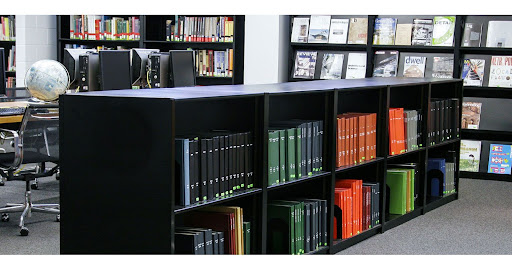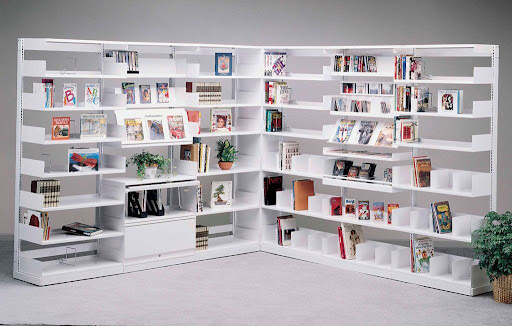Gone are the days when libraries were isolating hotspots of knowledge and silence. Today, people visit libraries for many different reasons, ranging from job applications, meetings, and group studies to children’s activity sessions. There has also been a growing change in reading habits where people are far more equipped and habitual with e-books and virtually available content.
Such drastic change means people are no longer willing to invest time and energy to go through stacks of books. With more space needed for other activities, having efficient storage has become integral for libraries to survive. One effective solution to this growing problem is investing in library shelves. Commonly used for storage and shelving solutions, how your library is organized can drastically impact visitor behavior. This article provides a deep insight into the different types of library shelves and how investing in them can be beneficial.

Types Of Library Shelves:
Library shelvings come in a variety of designs and styles. However, generally library shelves can be categorized into four types based on their purpose and materials:
Cantilever Style Shelving:
Cantilever style, also known as bracket style shelves, are shelving systems designed for multimedia storage and displays. These are also one of the most common types of book storage shelves. In terms of functionality, cantilever shelves are very flexible, robust, and economical options. Common styles among cantilever shelves are:
- Canopy Tops: These are finished details usually used for multiple reasons, including additional worksurface, storage shelf, and keeping books safe from dust. These are also used to provide added strength.
- End Panels: As the name suggests, end panels are used as a finished range end closure. In most cases, end panels are highly customizable and are used as both design and functional shelves. These mostly come in handy for extra storage.
- Filler Units: Filler units come in various styles designed to maximize space in an architectural void and can be used for multiple purposes.
- Display Shelvings: These kinds of shelving are designed to showcase any type of display at a traditional store. Most displays are used for promoting new releases or bestsellers. Display shelves are also commonly used for multimedia displays in libraries. Zig-zag displays are one of the most popular book display styles. These also come in several other formats, including freestanding, slidings, trays, and hangings.
- Reference Shelves: Reference shelves are designed for the reference section in a library. The reference sections are mainly used to store information-heavy content like encyclopedias, dictionaries, and reference handouts. These can be retractable and may also come in both side access panel designs.
- Newspaper Shelves: As the name suggests, newspaper shelves are designed to hold newspapers. These come in various formats, including traditional wood sticks, racks to stack newspapers, and sloped periodical shelves.
- Periodical Display Shelves: These specially designed shelves are used to spotlight current periodicals. The racks are slightly angled and sloped, allowing them to be lifted for a better view. These are mostly used for newly released journals, publications, magazines, and other periodicals.
Case-Style Shelving:
Any shelving system that utilizes full panels with adjustable shelves is called case-style shelving. These come with a canopy top and are available in single-faced and double-faced variations. In addition, due to their finished look, these usually make perfect additions for meeting rooms, offices, and spaces that need an aesthetic touch.
Case-style shelves also come in mobile and stationary designs. Since these are universally slotted, these shelves provide a far more versatile library storage option. Case-style shelving systems offer larger floor space and storage capability than cantilever shelves.
Compact Shelving Units:
Compact shelvings are shelving systems with floor-installed moveable carriages. One of the most significant advantages of compact shelving systems is that they provide excellent floor space and come with a relocatable access aisle. Stacks can be compressed into smaller units to maximize floor space.
This also means compact shelvings can be used to store older, not in-demand, books by consolidating the shelves until they are needed. In addition, compact shelving can hold up to three times as many books as conventional shelves. These come in both manual and electronic moving formats.
Multi-Tier Stack Shelves:
Multi-tier shelving systems are specially designed steel shelvings with multiple storage levels. In these shelvings, two or more racks are assembled over each other to maximize vertical space. As a library shelving system, these offer a range of benefits. First, multi-tier shelves are cost-effective options when it comes to extra storage.
Moreover, libraries can efficiently address their rising storage issues by adding another rack. These kinds of shelves are also excellent alternatives to cantilever shelving, especially when it comes to storing reference books. What distinguishes them from other shelving systems is that most multi-tier shelves are built with multiple stories with attached walkways.

Benefits Of Library Shelvings:
Library shelvings serve two primary functions: storage and helping maximize floor space. However, library shelves also serve many other functions beyond their storage capabilities. From adequate organization to effective marketing, here are some benefits of investing in library shelving.
Sense Of Organization:
When it comes to a library, having a sense of organization is integral. Although libraries today serve more functions than just storage, their primary objective remains to keep book collections safe and protected. A well-organized library can not only assist visitors in finding what they are looking for but also uplift the overall flow of the space.
A library shelving system is an excellent way of maintaining a sense of organization. First, it allows for effectively storing books, CDs, and other products on display at your library. Second, beyond just practical storage, shelves are excellent tools for systematically organizing books.
For instance, most libraries club books of the same genre together to allow readers to distinguish between different collections. With a welded 1000 shelf, you can take this a notch higher and create a spatial gap between various categories to reduce effort on the part of the reader.
Efficient Use Of Space:
Efficient use of space is one of the most significant benefits of having a library shelf. Today, library owners can get access to a range of unique frames designed for specific purposes. For instance, display units and newspaper racks are excellent storage solutions for easy-to-ignore places like wall corners.
Not only can these operate as attention grabbers for potential visitors, but they also allow you to use more extensive shelves for more popular categories. Investing in different shelves will enable you to efficiently use even the smallest space to store books and other collections. Similarly, mobile library carts and System 30 shelves offer much more versatile and open storage for smaller displays.
Versatile Options:
Different types of library shelvings serve different storage purposes. However, with a versatile range of options, you can get access to shelves that fit perfectly with your library design. Library owners must often alter their book organization to accommodate new releases. Since most library shelves come in a versatile design, you do not have to worry about storing old collections.
Mobile shelves, column extenders, multiple-tier browser boxes, and adjustable caster units are some excellent examples of versatile storage. These storage options come in a flexible design and can accommodate all kinds of storage demands. A versatile design means library shelves can complement all types of spaces and can also be used to bring a new touch.
Better Accessibility:
Accessibility is one key aspect of running a library. If your collections are not readily accessible to visitors, you run the risk of losing out on potential profits. This is especially true for older books and publications that are no longer popular among the general public. Besides storage, certain library shelves can make books more accessible to visitors.
For instance, storing new releases and publications in caster units can be counterproductive. Instead, these publications must be placed in easy-to-spot storage units to grab attention. Library shelves like zig-zag and periodical displays are designed for effective marketing and boosting sales.
Similarly, when it comes to older, less popular collections, most libraries store them in enclosed boxes. This can further reduce the probability of sales among visitors. Library shelves like Canopy Tops, Steel End Panels, and Closed Backs are a few ways you can improve access to rare and older books at your store.
Cost-Effective Solution:
You wouldn’t want to invest in something that does not bring you good returns. That is one of the reasons why libraries invest in different shelves instead of designing custom storage. While custom storage solutions are ideal, they can fall short of benefits over time.
Library shelves, on the contrary, are excellent cost-effective storage solutions. As durable units, you do not have to worry about replacing or repairing them for proper functioning. A standard library shelf can last you several years before you’d need to replace it.
You can also choose from several materials, mainly wood, plastic, and metal. You can select an option that best suits your pocket, depending on your budget and needs. Library shelves are also very dynamic in design and can be used for storing other materials like DVDs and goodies.

Saves Time And Energy:
One of the most underrated benefits of investing in library shelves is the time and energy they can help you save. Contrary to what people may believe, running a library can be physically demanding. Library owners often have to spend grueling hours organizing their storage, from ensuring where specific genres are stored to re-arranging the racks based on new releases.
Library shelves like sliding door cabinets, caster units, and multi-tier shelves can be an amazing help for such tasks. They make it easier to identify the books without spending hours checking each cabinet. These shelves can also be color coded or numbered based on different categories like genres, bestsellers, authors, and formats.
Easy Identification:
Segregation of books is an essential part of running a library. But much like accessibility, easy identification is crucial for a library’s sales. In fact, access to different genres and identification of categories are just different sides of the same coin.
For visitors to be able to access your whole collection, they must have a way to identify books quickly. While specific categories can be made more accessible and visible via display shelves, these cannot be used for the general collection. For easy identification, you need an intelligent segregation system.
As dynamic tools, library shelves allow segregating and organizing the space effectively. Just as color-coded shelves and numbered cabinets can help librarians keep track of their space, library shelves can also help visitors navigate the store quickly. Reference shelves, double-faced units, and concealed caster units are excellent ways to make books easily identifiable.
Open Back VS Closed Back:
The back design is another critical consideration when investing in a library shelf.
Open-back shelvings come in a bookcase-type design. However, instead of being enclosed, they have an open space style. Open-back shelvings are excellent for double-facing library spaces. But remember, these can make book organization a little tricky since a lack of back support means books are prone to falling.
Closed-back shelvings, on the contrary, provide a much more stable organization of books. These usually come with a steel back and three enclosed side panels. While these may not be as accessible as open-back shelves, they provide better aesthetic appeal and book protection.
The kind of library shelving you should invest in depends significantly on your specific needs. However, as a general note, it is essential to consider the versatility and diverse functions when selecting suitable shelving.
Final Thoughts:
Undoubtedly, library shelvings are an essential component of running a bookstore. Your store organization, accessibility, space maximization, and storage heavily depend on the shelving you invest in. These factors together contribute to customer experience and, by extension, your sales and performance. That is why investing in shelving is a matter of great significance. Ensure to make an informed decision when planning to invest in library shelving systems.
